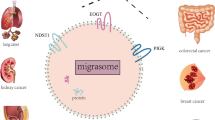Abstract
The enhanced ability of cancer cell migration and metastasis is the major cause for the cancer-related death of hepatocellular carcinoma (HCC). Better understanding the mechanisms for the motility of cancer cells will benefit the treatment. Diaphanous-related formin 3 (DIAPH3) has been reported to regulate the motility of cells by remodeling the cytoskeleton. However, the mechanism through which DIAPH3 regulated the motility of cancer cells remains largely unknown. In this study, we have shown that the expression of DIAPH3 was up-regulated in HCC. DIAPH3 positively regulated the growth, migration, colony formation, epithelia mesenchymal transition, and metastasis of HCC cells. Mechanically, DIAPH3 activated the beta-catenin/TCF signaling by binding HSP90 and disrupting the interaction between GSK3beta and HSP90. Taken together, our study demonstrated the oncogenic activity of DIAPH3 in the progression of HCC and suggested that PDIAPH3 might be a therapeutic target.






Similar content being viewed by others
References
Katoh M, Katoh M (2004) Identification and characterization of human FHOD3 gene in silico. Int J Mol Med 13:615–620
Wicki A, Lehembre F, Wick N, Hantusch B, Kerjaschki D, Christofori G (2006) Tumor invasion in the absence of epithelial-mesenchymal transition: podoplanin-mediated remodeling of the actin cytoskeleton. Cancer Cell 9:261–272
Ocana OH, Corcoles R, Fabra A, Moreno-Bueno G, Acloque H, Vega S, Barrallo-Gimeno A, Cano A, Nieto MA (2012) Metastatic colonization requires the repression of the epithelial-mesenchymal transition inducer Prrx1. Cancer Cell 22:709–724
Serresi M, Gargiulo G, Proost N, Siteur B, Cesaroni M, Koppens M, Xie H, Sutherland KD, Hulsman D, Citterio E, Orkin S, Berns A, van Lohuizen M (2016) Polycomb repressive complex 2 is a barrier to KRAS-driven inflammation and epithelial-mesenchymal transition in non-small-cell lung cancer. Cancer Cell 29:17–31
He X (2006) Unwinding a path to nuclear beta-catenin. Cell 127:40–42
Jessen JR, Solnica-Krezel L (2005) Axis formation–beta-catenin catches a Wnt. Cell 120:736–737
Macdonald BT, Semenov MV, He X (2007) SnapShot: Wnt/beta-catenin signaling. Cell 131:1204
Surel C, Guillet M, Lenoir M, Bourien J, Sendin G, Joly W, Delprat B, Lesperance MM, Puel JL, Nouvian R (2016) Remodeling of the inner hair cell microtubule meshwork in a mouse model of auditory neuropathy AUNA1. eNeuro. doi:10.1523/ENEURO.0295-16.2016
Calvo F, Ege N, Grande-Garcia A, Hooper S, Jenkins RP, Chaudhry SI, Harrington K, Williamson P, Moeendarbary E, Charras G, Sahai E (2013) Mechanotransduction and YAP-dependent matrix remodelling is required for the generation and maintenance of cancer-associated fibroblasts. Nat Cell Biol 15:637–646
Schoen CJ, Burmeister M, Lesperance MM (2013) Diaphanous homolog 3 (Diap3) overexpression causes progressive hearing loss and inner hair cell defects in a transgenic mouse model of human deafness. PLoS ONE 8:e56520
Schoen CJ, Emery SB, Thorne MC, Ammana HR, Sliwerska E, Arnett J, Hortsch M, Hannan F, Burmeister M, Lesperance MM (2010) Increased activity of Diaphanous homolog 3 (DIAPH3)/diaphanous causes hearing defects in humans with auditory neuropathy and in Drosophila. Proc Natl Acad Sci USA 107:13396–13401
Katoh M, Katoh M (2004) Identification and characterization of human FHOD3 gene in silico. Int J Mol Med 13:615–620
Lin YN, Windhorst S (2016) Diaphanous-related formin 1 as a target for tumor therapy. Biochem Soc Trans 44:1289–1293
Hager MH, Morley S, Bielenberg DR, Gao S, Morello M, Holcomb IN, Liu W, Mouneimne G, Demichelis F, Kim J, Solomon KR, Adam RM, Isaacs WB, Higgs HN, Vessella RL, Di Vizio D, Freeman MR (2012) DIAPH3 governs the cellular transition to the amoeboid tumour phenotype. EMBO Mol Med 4:743–760
Cooper LC, Prinsloo E, Edkins AL, Blatch GL (2011) Hsp90alpha/beta associates with the GSK3beta/axin1/phospho-beta-catenin complex in the human MCF-7 epithelial breast cancer model. Biochem Biophys Res Commun 413:550–554
Acknowledgements
This work was supported by the Nature Science Foundation of Inner Mongolia (2015MS08144) and National Science Foundation (Grant No. 8123406).
Author contributions
LD and RG designed this project. ZL, LX, GL, CZ, ZC, HL performed the experiments.
Author information
Authors and Affiliations
Corresponding author
Ethics declarations
Conflict of interest
The authors declare that they have no conflict of interest.
Ethical approval
All procedures performed in studies involving human participants were in accordance with the ethical standards of the institutional and/or national research committee and with the 1964 Helsinki declaration and its later amendments or comparable ethical standards.
Research involving human and animal participants
All applicable international, national, and/or institutional guidelines for the care and use of animals were followed.
Rights and permissions
About this article
Cite this article
Dong, L., Li, Z., Xue, L. et al. DIAPH3 promoted the growth, migration and metastasis of hepatocellular carcinoma cells by activating beta-catenin/TCF signaling. Mol Cell Biochem 438, 183–190 (2018). https://doi.org/10.1007/s11010-017-3125-7
Received:
Accepted:
Published:
Issue Date:
DOI: https://doi.org/10.1007/s11010-017-3125-7




